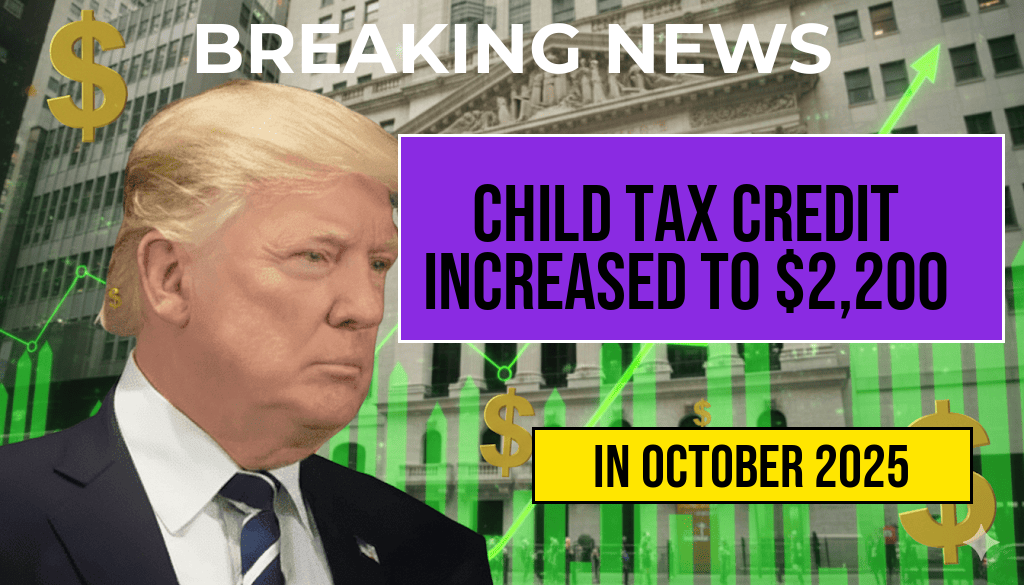Legislation enacted earlier this year has significantly increased the Child Tax Credit (CTC), boosting the maximum benefit to $2,200 per qualifying child. This adjustment aims to provide broader financial support to millions of American families, particularly those facing economic challenges. The new threshold, which was part of recent federal budget and relief measures, marks a notable expansion from previous levels, offering families a more substantial safety net. Experts estimate that this increase could deliver direct financial relief to over 40 million households nationwide, helping to offset rising costs in housing, childcare, and education. The change is part of a broader effort to address child poverty and promote economic stability, especially in the wake of ongoing recovery efforts following the COVID-19 pandemic.
Background of the Child Tax Credit Expansion
The Child Tax Credit has historically served as a key element of the U.S. social safety net, providing tax relief to families with children. Prior to the recent enhancement, the maximum credit was generally capped at $2,000 per child, with some provisions allowing for partial refunds. The recent legislation, signed into law in early 2023, increased the maximum amount and expanded eligibility criteria, aiming to reach more low- and middle-income families.
Details of the New Benefit Structure
| Aspect | Previous Law | New Law (2023+) |
|---|---|---|
| Maximum Credit per Child | $2,000 | $2,200 |
| Age Eligibility | Under 17 | Under 17 |
| Income Phase-Out Range | $75,000 (single), $110,000 (married filing jointly) | $75,000 (single), $150,000 (married filing jointly) |
| Refundability | Partial | Enhanced refundable portion |
The increase to $2,200 per child applies primarily to children under age 17, with higher income thresholds allowing more families to qualify fully for the expanded benefit. The updated refundability provisions mean that even families who owe little or no federal income tax can receive a meaningful cash benefit, addressing concerns about the program’s reach.
Impact on Families and Economic Stability
Economists and social policy analysts project that the increased Child Tax Credit will have a tangible impact on household finances. A report from the Urban Institute estimates that families with children could see an average increase of approximately $1,000 annually in their tax credits, providing additional funds for essentials like food, healthcare, and housing.
Support for Low- and Middle-Income Households
- More families qualify for the full benefit, reducing child poverty rates.
- The refundable portion helps families who do not have enough income to benefit from traditional tax credits.
- Provides a buffer against economic shocks, especially in areas with high living costs.
Broader Economic Effects
- Increased disposable income may stimulate local economies.
- Potential reduction in reliance on emergency assistance programs.
- Encourages workforce participation among parents seeking affordable childcare options.
Implementation and Accessibility
The IRS has updated its systems to accommodate the new credit levels, with most eligible families automatically receiving the increased benefits through their annual tax filings or advance payments. The IRS’s Child Tax Credit portal offers guidance and resources for families seeking to understand their eligibility and claim the benefit. For more detailed information, the official IRS website provides comprehensive guidance (IRS Child Tax Credit Info).
Policy Perspectives and Future Considerations
Advocates argue that the increased Child Tax Credit is a vital step toward reducing child poverty and promoting economic mobility. Critics, however, emphasize the need for sustainable funding and question whether the current expansion can be maintained long-term without impacting federal budgets. Discussions about making the enhancements permanent are ongoing in Congress, with some lawmakers pushing for broader reforms to child benefits and family support programs.
As the fiscal year progresses, monitoring the program’s reach and effectiveness will be essential. Data from the IRS and social agencies will shed light on how the increased benefit influences family well-being and economic resilience across different regions.
For additional insights into how child benefits shape economic policy, see this analysis from Forbes (Forbes: Child Tax Credit Impact) and the Wikipedia entry on Child Tax Credit.
Frequently Asked Questions
What is the new amount for the Child Tax Credit?
The Child Tax Credit has been increased to $2,200 per qualifying child, providing greater financial support to families.
Who is eligible for the increased Child Tax Credit?
Eligible families are those with dependent children under age 17 who meet income requirements and other criteria outlined by the IRS.
When does the increased Child Tax Credit take effect?
The increase to the Child Tax Credit is effective starting with the current tax year, offering immediate relief to eligible families.
How does the increased Child Tax Credit impact my tax refund?
The higher Child Tax Credit can significantly reduce your tax liability and may increase your refund amount, depending on your income and tax situation.
Are there any changes to how the Child Tax Credit is claimed?
Families can claim the increased Child Tax Credit using their annual tax return, and additional advance payments may be available in some cases, as per the latest IRS guidance.







